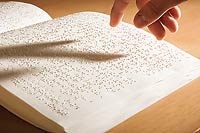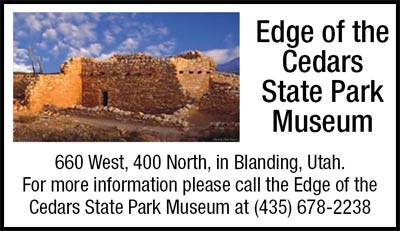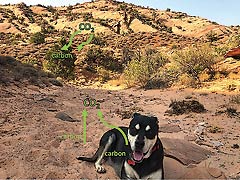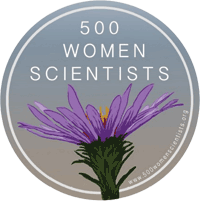|
|
SCIENCE HAPPENINGS December 2019 |
| Archaeology Tailored For Visually Impaired |
The Edge of the Cedars State Park Museum presents “Making Sense of Archaeology,” an exhibition by the Utah Division of State History open to the public November 2 through December 31, 2019. 
The exhibit is an educational hands-on scientific and historical experience specifically tailored for people who are blind or have low vision. It features 3D printed objects that represent important specimens, and artifacts from Utah. Objects are imbedded with 3D printed braille and audio content. Participants are able to read and listen to a short history of the object while touching the objects on display. It is the first fully 3D printed traveling archaeological exhibit. It was produced by the Public Archaeology Program Utah Division of State History, in partnership with the Utah School for the Blind, Utah STEM Action Center, and the Utah Blind Institute.
“Utah houses the largest braille library west of Mississippi River and people who are blind travel here from all over the country to learn how to utilize their other senses to live and engage in the world around them. Museums are some of the best sources for hands-on learning,“ said Shawn Lambert exhibit producer and Public Archaeologist for the Utah Division of State History.
The Prehistoric Museum features fossils and artifacts from Utah. This special exhibition is located in the changing exhibit gallery of the museum and runs from Saturday, November 2 through Tuesday, December 31, 2019.
 Winter Hours: November 1, 2019- February 29, 2020 7 days a week, 9am-2pm. Closed Christmas Eve, Christmas Day, New Year’s Eve, and New Year’s Day. Edge of the Cedars State Park Museum 660 W 400 N Blanding, Utah. For info: 435-678-2238 or stateparks.utah.gov/parks/edge-of-the-cedars. General admission rates apply. Winter Hours: November 1, 2019- February 29, 2020 7 days a week, 9am-2pm. Closed Christmas Eve, Christmas Day, New Year’s Eve, and New Year’s Day. Edge of the Cedars State Park Museum 660 W 400 N Blanding, Utah. For info: 435-678-2238 or stateparks.utah.gov/parks/edge-of-the-cedars. General admission rates apply.
Be sure to mention that you read about it in the Moab Happenings.
|
| Biogeochemistry: an uninviting name for a fabulous kind of science |
Biogeochemistry might sound like the name of all the classes people didn’t want to take in high school all squished into one word, but it’s actually a type of science that allows us to ask exciting questions about how our world works and how it’s responding to change. Biogeochemistry is the study of how elements – elements like carbon, nitrogen, and phosphorus – move around or hang out in different parts of ecosystems (such as plants, or soil, or you). Biogeochemists think about this as a cycle-- like a life cycle but for elements, and we study the cycles of the elements we think are important. For example, biogeochemistry is a tool we can use to know how fertile a given soil is, or to see if a type of pollution is affecting native plants, or to determine how much carbon dioxide we might be able to sequester out of our atmosphere. 
Lots of environmental challenges are also issues that have biogeochemistry at their cores. For example, climate change is driven by changes to our planet’s carbon cycle, where we have more carbon being transformed into carbon dioxide and moving into our atmosphere. Any given ecosystem is very complex, and biogeochemistry lets us distill this complexity into just tracking the elements. So instead of needing to know everything about all of the plants, biocrusts, soils, microbes, and atmospheric components of a place, biogeochemists can stalk just a few kinds of molecules and learn important things about how that place works. Learning about the other parts of the system is important too, but biogeochemistry is a newer tool in our scientific toolbox that gives us powerful ways to explore.
And biogeochemistry is a different way to try and see the world around you. Next time you’re out on a hike, think about how cool it is that the plants and biological soil crusts you see are sucking up carbon dioxide out of the atmosphere and turning it into sugar to fuel their lives (through photosynthesis). How amazing it is that some of the carbon that was trapped in your breakfast is being released as you breathe out the carbon dioxide that comes from the chemical transformations your body is performing to fuel your walk. And before being your breakfast, that same carbon may have been in the soil of a rain forest, or floating above New York City, or part of a jellyfish off the coast of Thailand. Biogeochemistry helps us remember that, like all living things on our planet, we are carbon-based life forms and we are all connected.
 Southeast Utah 500 Women Scientists
Mission and Values: Southeast Utah 500 Women Scientists
Mission and Values:
Our Mission:
• To share the importance of science.
• To support one another as a community of women scientists in Southeast Utah
• To be in service in the name of science to the communities of Southeast Utah.
Our Values
Being a supportive group for women scientists in Southeast Utah
Advocate for inclusivity in our group and in science at large
Increase scientific literacy for locals and tourists
Mentor and support students of science (especially girls) |
|
|
|
|
|
|
© 2002-2024 Moab Happenings. All rights
reserved.
Reproduction of information contained in this site is
expressly prohibited.
|
|